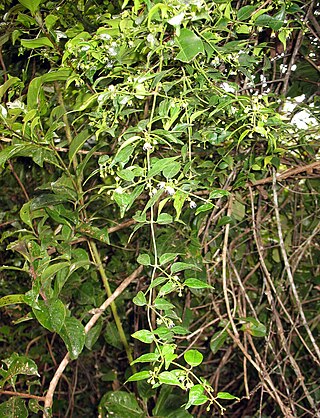
The Asclepiadoideae are a subfamily of plants in the family Apocynaceae. Formerly, it was treated as a separate family under the name Asclepiadaceae, e.g. by APG II, and known as the milkweed family.

Stapeliinae is a subtribe of flowering plants within the tribe Ceropegieae of the subfamily Asclepiadoideae of the family Apocynaceae. The subtribe comprises about 35 genera, including both the stem-succulent "stapeliads" and the horticulturally popular genera Brachystelma and Ceropegia. The largest number of genera are native to Africa, but a more limited number of genera are widespread in Arabia and Asia. Historically, a similarly circumscribed taxon was treated as a separate tribe, Stapelieae.
Australluma peschii is a species of plant in the family Apocynaceae. It is native to Angola and Namibia. Its natural habitat is dry savanna. It is threatened by habitat loss.
Australluma is a genus of plant in family Apocynaceae.
Mesembryanthemum tomentosum, synonyms including Brownanthus pubescens, is a species of plant in the family Aizoaceae. It is native to the Cape Provinces and Namibia. Its natural habitats are dry savanna and rocky areas.

Hoodia juttae is a species of plant in the family Apocynaceae. It is endemic to Namibia. Its natural habitats are rocky areas and cold desert. H. juttae is found around the Little and Great Karas mountains. It is threatened by collection. The plant was discovered by Jutta Dinter, the wife of botanist, Kurt Dinter in 1913. The scientific name refers to Jutta.

Hoodia ruschii is a species of stem succulent plant in the family Apocynaceae. It is endemic to Namibia. Its natural habitats are rocky areas and cold desert.

Lachemilla angustata is a species of plant in the family Rosaceae. It is endemic to Ecuador. As of February 2023, the genus Lachemilla was included in Alchemilla by Plants of the World Online, with Lachemilla angustata treated as "unplaced". Alchemilla angustataS.E.Fröhner is a different species, native to the Pyrenees.

Lavrania is a monospecific genus of plants in family Apocynaceae. Its only species is Lavrania haagnerae, endemic to Namibia. Its natural habitat is rocky areas.

Cynanchum socotranum, synonym Sarcostemma socotranum, is a species of plant in the family Apocynaceae. It is endemic to Socotra Island, south of Yemen. Its natural habitat is subtropical or tropical dry shrubland.

Tridentea pachyrrhiza is a species of plant in the family Apocynaceae that is native to Namibia and South Africa.

Stapelianthus is a genus of flowering plants in the family Apocynaceae, first described as a genus in 1933. The entire genus is endemic to Madagascar and is concentrated in the far south of the island.

Diplorhynchus is a monotypic genus of plant in the family Apocynaceae native to tropical and southern Africa. As of August 2020, Plants of the World Online recognises the single species Diplorhynchus condylocarpon.

Fockea is a genus of succulent scrubs native to Africa south of the equator. They are members of the Asclepiadoideae (milkweeds), a subfamily of the dogbane family Apocynaceae. Of the six recognized species, only the two most widely distributed extend north of southern Africa, with F. multiflora reaching as far north as Tanzania and F. angustifolia reaching to southern Kenya. Fockea are known as water roots, a reference to the bulbous caudex characteristic of most species, which is also edible in at least some species.

Orbea is a genus of flowering plants of the family Apocynaceae, first described as a genus in 1812. It is native to Africa and the Arabian Peninsula.
Portulacaria carrissoana is a shrubby succulent plant found on the border between Namibia and Angola.

Fockea multiflora, or python vine, is a plant of the dogbane family, Apocynaceae, native to Tanzania, Mozambique, Zimbabwe, Zambia, Angola, Botswana, Namibia, including the Caprivi Strip, and Malawi. It is a large semisucculent liana, growing to some 15m in length and up to 60 cm in diameter, found primarily in the seasonally dry tropical biome.
Stephanotis arabica, synonyms including Dregea arabica and Marsdenia robusta, is a species of flowering plant in the family Apocynaceae, native to Socotra and mainland Yemen. It was first described by Joseph Decaisne in 1844.

Camptocarpus acuminatus is a species of plant in the Apocynaceae family. It is endemic to the Madagascar. Pierre Choux, the botanist who first formally described the species, named it after the tapering tips of its leaves, using the synonymous name Tanulepis acuminata.

Camptocarpus semihastatus is a species of plant in the Apocynaceae family. It is native to Madagascar. Jens Klackenberg, the botanist who formally described the species named it after the distinct coronal lobes of its flowers that resemble half the head of a spear.
















